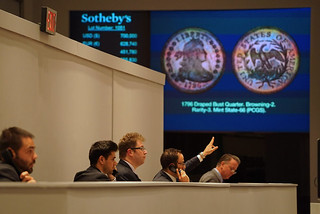
PREV ARTICLE
NEXT ARTICLE
FULL ISSUE
PREV FULL ISSUE
NEW YORK TIMES COVERS POGUE SALE
The New York Times covered the recent Pogue sale in the context of an article on how great collections of any type are brought to
market successfully. While illustrated with many coins, the article also touches on sales of art, Egyptian artifacts, and $11 million of
duck decoys. Thanks to Harvey Stack for passing this along. -Editor
“The only value of that coin is my sentimental attachment to it,” Mr. Pogue said from his home in Dallas. He estimated the penny is probably worth 2 cents today. But he went on to buy far rarer coins, including the only 1822 Half Eagle gold piece in private hands, in a 40-year quest to build the pre-eminent collection of early American coins. “I fell in love with the history of our country, the history of our coins, the artistic beauty of our coins,” he said. Mr. Pogue, 50, has decided to sell his collection of some 680 coins, which the specialty auction house Stack’s Bowers Galleries estimates could fetch more than $200 million. Not bad for pocket change with a face value of $769.14, according to Brian Kendrella, president of Stack’s Bowers. Mr. Pogue has a particularly rich collection of coins with a built-in audience of coin enthusiasts. Even so, strategy is the key to getting the most from the sale of a collection. That is why Stack’s Bowers has spaced out the coin sales over seven auctions in the next three years. The first was last week. A 1797 half dollar. The first auction of Mr. Pogue’s coins brought in $25 million, and six more are planned. Credit Nicole Bengiveno/The New York Times And while it is a heady time in the art and auction world — Christie’s recently set a record by selling more than $1 billion of postwar and contemporary art in one week — such headline-grabbing numbers make selling art seem easy. In most cases, selling a collection will take years and result in many unsold pieces. To prevent disappointment — or worse, many unsold lots — sellers need to ask tough questions of the auction houses or galleries that want to represent them, and be reasonable about the value of what they have amassed. The first thing someone wanting to sell a collection needs is a story to hold it together. “Many people can put together groups of things that are called collections,” said Jonathan Rendell, a deputy chairman of Christie’s. “But a really great collection is completely bound together. The objects and the collector are one thing.” To read the complete article, see:
Wayne Homren, Editor The Numismatic Bibliomania Society is a non-profit organization promoting numismatic literature. See our web site at coinbooks.org. To submit items for publication in The E-Sylum, write to the Editor at this address: whomren@gmail.com To subscribe go to: https://my.binhost.com/lists/listinfo/esylum All Rights Reserved. NBS Home Page Contact the NBS webmaster 
|
